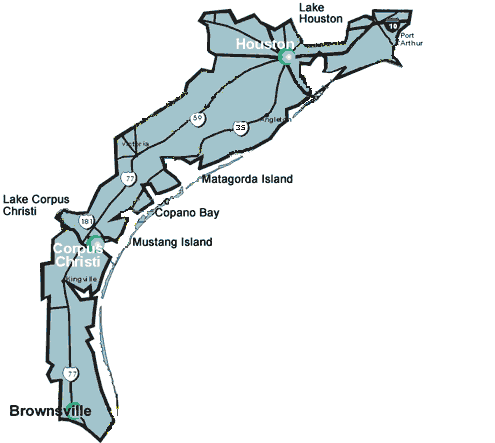 |
|
 |
||||||
Gulf Coast
Gulf Coast Towns
Barrett (Harris County)
Dinsmore - "Dinsmore is on Farm Road 1301 and the Galveston, Harrisburg and San Antonio Railway two miles east of Wharton in Wharton County. It was established in John Dinsmore's quarter league by a black man, E. W. Roberts, for African Americans. qv The plat was recorded in 1913, and the town was named Roberts; the residents, however, called the place Dinsmore, and the name Roberts appears only on the plats. The original plat had thirty-eight blocks, with nine avenues running east to west and six streets running north to south. One lot was designated for a school, with a park across the street. The streets and avenues had the names of local citizens. The lots were small but cheap, and gave descendants of former slaves, now working as tenant farmers, sharecroppers, or hired agricultural workers, a place to build and own their own homes. The site was near Burr, which had the largest black population in the county because the large plantations along the Caney Creek had been in that area.
After the railroad was built from Wharton to Van Vleck in 1900, white farmers moved in. E. W. Roberts, who owned and operated a brick two-story mercantile store on the east side of the courthouse square in Wharton, began selling lots in 1914. He eventually declared bankruptcy, sold all of his Wharton County holdings, and moved to Houston. A revised plat was recorded in 1920 that reduced the townsite to three avenues, four streets, and ten blocks containing twelve lots each. The school and park never materialized. In the early 1990s Dinsmore comprised fifty houses, an estimated 250 residents, and one business."-Bibliography:
Wharton County Historical Commission, Wharton County Pictorial History: 1846-1946, Our First 100 Years (Austin: Eakin Press, 1993).Houston Freedmen's Towns: There were several Freedman settlements established in the location of present-day Houston. At the time of settlement, these places were located outside of Houston and as Houston expanded, these areas were incorporated. These settlements included the Fourth and Fifth Ward, and Freedmanís Town:
Fifth Ward
Fourth Ward
Freedmanís Town: "Historical and cultural legacies bounded by Gennessee, West Dallas, Arthur and West Gray Streets. This 40 block residential area represents the first settlement of the Cityís freed blacks. The district contains many examples of shotgun houses. Rutherford B. Yates House Historical and cultural legacies, 1314 Andrews in Freedmanís Town. The building will house a museum that will focus on the work of African-American printers. RTHL is designated a recorded Texas Historic Landmark.Antioch Missionary Baptist Church - Historical and cultural legacies, 313 Robin Street. Located in historic Freedmanís Town, this church was organized in 1866 and is the oldest Black Baptist congregation in Houston. Independence Heights Historical and cultural legacies bounded by North Yale, East 34th and I-610. This community was established about 1908 as middle-class African-American families began moving into the North Houston area. The first African-American Community to be incorporated in Texas, Independence Heights operated as a city from 1915 until annexation by the City of Houston. SM at 7818 N. Main, NR."
-Bibliography:
Freedmanís Town Historic District. Texas Historical Subject Marker. Listed in the National Register of Historic Places.Hufsmith (Harris County)
Kendleton
Mission Valley (Medina County)Sources
"DINSMORE, TX." The Handbook of Texas Online. [Accessed Fri Jul 4 7:51:06 US/Central 2003 ]. by Merle R. Hudgins.
![]()
